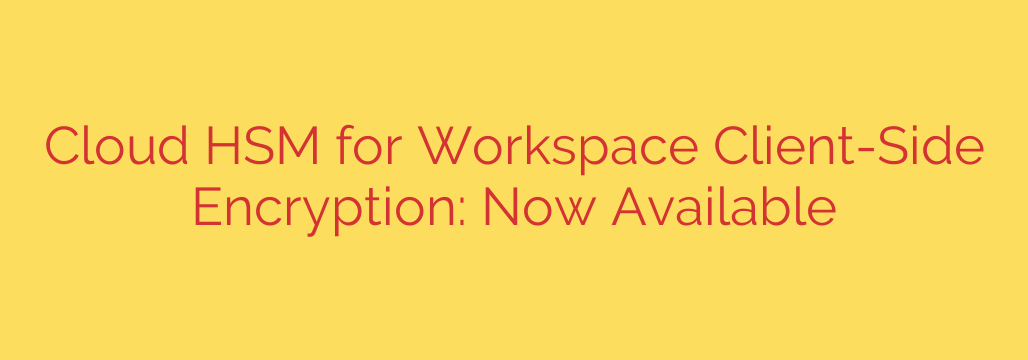
Unlocking Ultimate Data Control: Google Workspace Adds Cloud HSM for Client-Side Encryption
In the ongoing quest for robust data security, organizations face a constant challenge: how to leverage the collaborative power of the cloud while maintaining absolute control over their most sensitive information. For many, especially those in highly regulated industries, the answer lies in who holds the encryption keys. A significant advancement in this area now provides an unparalleled level of security and control for Google Workspace users.
By integrating its powerful Client-Side Encryption (CSE) with Cloud HSM, Google has established a new gold standard for protecting confidential data in services like Gmail, Drive, Docs, and Calendar. This move directly addresses the needs of organizations that require the highest level of security and provable control over their cryptographic keys.
What is Client-Side Encryption and Why Does It Matter?
Client-Side Encryption is a security model that ensures your data is unreadable before it ever leaves your device and reaches Google’s servers. With standard encryption, the cloud provider manages the encryption keys. With CSE, your organization controls the keys via a trusted third-party partner.
This means that Google has no access to the decryption keys and therefore cannot view your encrypted content. It offers a powerful layer of privacy and control, ensuring that your sensitive files, emails, and documents are accessible only by authorized users within your organization. This has been a game-changer for data privacy, but managing the keys has remained a critical responsibility.
The Next Level of Key Management: Introducing Cloud HSM
The latest enhancement takes this control to a new level. Organizations can now use Google Cloud’s Hardware Security Module (HSM) service to store and manage the encryption keys used for Workspace CSE.
An HSM is a dedicated, tamper-resistant physical device built specifically for securing cryptographic processes. It securely generates, stores, and manages digital keys, providing a fortress for your most critical security assets. By using Cloud HSM, you get the immense security benefits of a physical hardware module without the cost and complexity of purchasing and maintaining your own on-premise appliances.
Crucially, Cloud HSM is FIPS 140-2 Level 3 validated, one of the highest security certifications recognized globally. This certification ensures the hardware meets stringent requirements for physical security, tamper-resistance, and cryptographic integrity, making it suitable for government and enterprise use cases.
Key Benefits of Using Cloud HSM with Workspace CSE
Integrating Cloud HSM for your client-side encryption strategy delivers several powerful advantages:
- Unmatched Data Sovereignty: You maintain exclusive control over your encryption keys within a dedicated, managed hardware environment. Your data remains indecipherable to all outside parties, including the cloud provider.
- Simplified Regulatory Compliance: For organizations subject to regulations like HIPAA, GDPR, CJIS, or ITAR, using a FIPS 140-2 Level 3 validated HSM is often a mandatory requirement. This integration simplifies the path to achieving and proving compliance.
- Enhanced Security Posture: Keys are generated, stored, and used entirely within the protected boundaries of the HSM. This drastically reduces the attack surface and protects against both sophisticated external threats and potential insider risks.
- Seamless User Experience: While the back-end security is incredibly robust, the experience for the end-user remains seamless. Employees can continue to collaborate in familiar Workspace apps without disruption, while the organization’s most sensitive data remains protected.
Who Should Consider This Advanced Security Feature?
This solution is designed for organizations that cannot compromise on data security and control. Key industries that stand to benefit include:
- Government Agencies: Handling classified or sensitive public sector information.
- Financial Services: Protecting client financial data, trade secrets, and proprietary algorithms.
- Healthcare and Life Sciences: Securing patient health information (PHI) and complying with HIPAA.
- Legal and Professional Services: Maintaining attorney-client privilege and protecting sensitive case files.
- Engineering and Manufacturing: Safeguarding valuable intellectual property (IP) and trade secrets.
Actionable Steps for Implementation
If your organization handles highly sensitive data, moving to an HSM-backed encryption model is a critical security upgrade. Here are some high-level steps to get started:
- Assess Your Data: Begin by classifying your organization’s data. Identify which information is sensitive enough to require the protection of CSE and Cloud HSM.
- Configure Your Environment: Implementation involves setting up Cloud HSM within your Google Cloud project and configuring it to work with your chosen identity provider (IdP) and key management service.
- Enable in Workspace: Once the backend is configured, you can enable CSE for specific organizational units (OUs) within the Google Workspace Admin console.
- Implement a Phased Rollout: Start with a pilot group of users to ensure all configurations are working as expected before deploying the solution across the entire organization. This allows you to refine policies and provide targeted user training.
By combining the collaborative power of Google Workspace with the ultimate key security of Cloud HSM, organizations no longer have to choose between productivity and protection. They can now confidently embrace the cloud, knowing their most valuable digital assets are secured to the highest possible standard.
Source: https://cloud.google.com/blog/products/identity-security/introducing-cloud-hsm-as-an-encryption-key-service-for-workspace-cse/








